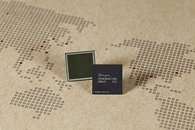Tuesday, December 31st 2013

SK Hynix Develops 8 Gb LPDDR4 Memory
SK Hynix Inc. announced that it has developed the world's first 8 Gb (Gigabit) LPDDR4 (Low Power DDR4) using its advanced 20 nm class technology. LPDDR4 is the next generation mobile DRAM interface on the process of standardization which features ultrahigh speed and low power consumption.
This new product works at 3200 Mbps and ultra low-voltage of 1.1V which runs two times faster than 1600 Mbps and does at lower voltage than 1.2V of existing LPDDR3. The Company has been strengthening its cooperation with the customers for the standardization of this new mobile DRAM by providing the samples of LPDDR4 to major customers and SoC(System on Chip) companies.Especially, SK Hynix is to continuously maintain its technology leadership in the mobile market by developing the world's first 8 Gb LPDDR4 following the development of the world's first 8 Gb and 6 Gb LPDDR3. The Company plans to start mass production of it from the second half of next year.
"SK Hynix secured its technology leadership by developing the world's first next generation mobile memory LPDDR4 and providing samples of the product to the customers" said Senior Vice President Richard Chin, the Head of Global Sales Marketing. "The Company will further strengthen its competitiveness in the mobile area with the development of high density, ultrahigh speed and low power consuming products" he added.
The new interface LPDDR4 is expected to be loaded onto flagship mobile devices at the end of 2014 and is anticipated to be commercialized regularly from 2015. Plus, it is expected to be the main product in the industry from 2016.
This new product works at 3200 Mbps and ultra low-voltage of 1.1V which runs two times faster than 1600 Mbps and does at lower voltage than 1.2V of existing LPDDR3. The Company has been strengthening its cooperation with the customers for the standardization of this new mobile DRAM by providing the samples of LPDDR4 to major customers and SoC(System on Chip) companies.Especially, SK Hynix is to continuously maintain its technology leadership in the mobile market by developing the world's first 8 Gb LPDDR4 following the development of the world's first 8 Gb and 6 Gb LPDDR3. The Company plans to start mass production of it from the second half of next year.
"SK Hynix secured its technology leadership by developing the world's first next generation mobile memory LPDDR4 and providing samples of the product to the customers" said Senior Vice President Richard Chin, the Head of Global Sales Marketing. "The Company will further strengthen its competitiveness in the mobile area with the development of high density, ultrahigh speed and low power consuming products" he added.
The new interface LPDDR4 is expected to be loaded onto flagship mobile devices at the end of 2014 and is anticipated to be commercialized regularly from 2015. Plus, it is expected to be the main product in the industry from 2016.

14 Comments on SK Hynix Develops 8 Gb LPDDR4 Memory
Samsung announced the exact same memory 3 days ago lol.
"Especially, SK Hynix is to continuously maintain its technology leadership in the mobile market by developing the world's first 8 Gb LPDDR4..."
samsung and hynix should have announced they managed to produce it, not that they are the first.
the more the better.
To give people a rough idea of bandwidth requirements and perspective to what this means for mobile, the flagship desktop Kaveri seems to be clocked for use with 3000mhz ram (over it's 128-bit bus).
At 3200mhz, granted probably on a 64-bit bus much of the time, that gives you an idea of what will be possible for mobile, which is pretty crazy. While you could more-or-less (granted because of latency differences and their effect on a cpu you may need slightly more bw) substitute any full cpu design aimed towards 1600mhz ddr3, Literally half a Kaveri, or such a design created within similar limitations for mobile/cheap pcs.
When you think about the chips these will go with; 16-14nm, or perhaps rather 20nm-finfet-named-14nm from both TSMC and the CPA (IBM, Samsung, GF), this will be a huge boon for mobile....huge. Think of what a phone/tablet/convertible/small notebook will be capable of with that much bandwidth aligned with some super space-saving transistors, even at low clocks....using very little power. Pretty amazing.
Every time you post, you're angry. I think you need to breathe for a minute.
Edit: 2 manufacturers saying they can make these chips? Who the Hell gives a crap who's first, having a "who's second" is much more important, it means potential buyers won't get imaginary premiums/overcharged, (unless they're both spoken and prices are rigged to begin with).
Edit2: Great news for the likes of AMD Beema/Mullins and beyond, lower power usage on RAM means more thermal power headroom for the APU itself, as well as faster speeds and bigger RAM sizes (OR simply, more battery time). Well, that is, if AMD gets with the program and starts using LPDDR at least for Mullins to begin with.
As I said, DDR1, 2, and 3 ranks have always been 64-bit per channel, which is the width of a single rank on a memory module, not a single IC.
Well, that and the fact that I really got better things to do (at the moment at least, this might change LOL) than start reading through pages and pages of articles and vague/ambiguous documentation.
Edit: typo.